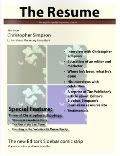CTRs: The "Car Through Rate"
Following WWII, the National Highway Act was put into effect and 40,000 miles of modern superhighways were created. While useful for the fast-growing car culture, it spelled the end for intimate, road-side ads like those made famous by Burma Shave. To adapt, advertisers created the billboard.
In other words, the (non-information) superhighway occasioned a brand new advertising medium.
vertising medium.
Now imagine if they had pitched the idea to their clients by stressing that since the target audience was already in their cars, it would now be possible to measure the success of the new medium by counting the cars that passed a billboard and then turned off at the next exit to purchase the advertised product.
They would have called this the “Car Through Rate,” or CTR.
It’s fortunate that such a “benefit” was never put forward because the expected behaviour, of course, would never have materialized. Clients would have judged the worth of billboards solely by the pitiful CTRs and costs would plunge. But while the CTR may not have been successful, the signs would still have performed the function of advertising -- putting images and copy in front of the consumer. This, coupled with the absurdly small cost, would provide incentive for an increase in the number of billboards erected, mostly by small-time business owners who knew little about advertising.
The result would be a plethora of ads whose innate effectiveness would be diminished both by their irritating and amateurish qualities as well as their sheer numbers.
Had Internet advertising been recognised from the beginning as no more, and certainly no less, effective than ads found in the pages of any other publication, the cost would have better reflected their worth. This, in turn, would have discouraged the explosion of cheap and poorly-conceived ads while attracting high-quality ads created by professional agencies.
There are differences, of course, between online ads and those appearing in physical publications, the most important, perhaps, being the restriction of real estate. But if small publications like TV Guide and Readers Digest could command high rates for their ads, then surely websites with equivalent readerships could have done the same. And as the size of screens increases, the real estate problem becomes far less of a problem.
The problem with Internet ads has never been that they don’t command people’s attention -- that’s a problem faced by all ads. A well-designed ad placed in front of 50,000 readers of an online magazine has exactly the same power as the same ad placed in front of 50,000 readers of a paper magazine. The problem is, when they didn’t perform miracles we began giving the online ads away -- and then complained that they weren’t brining in enough money.






